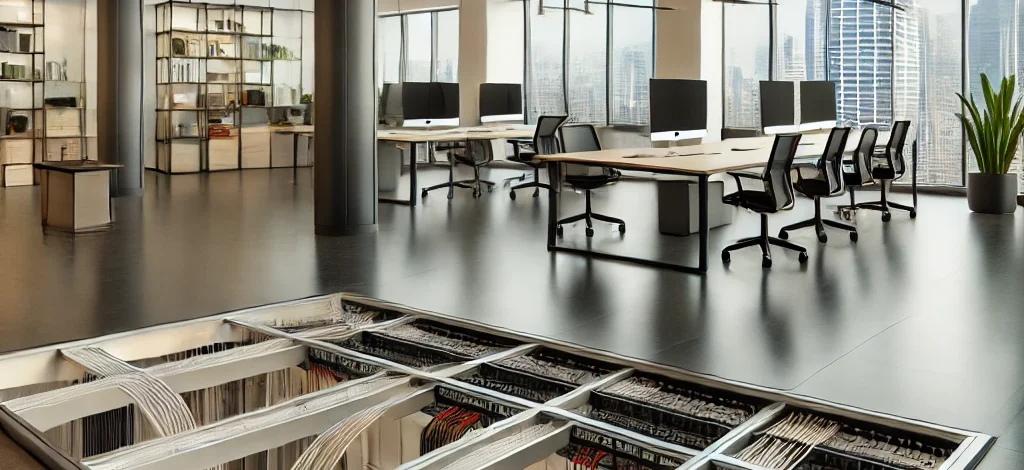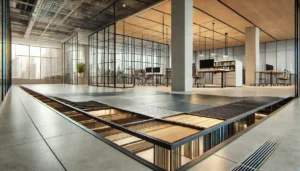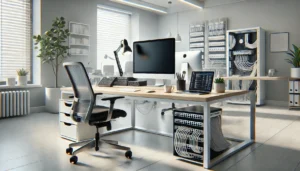How Raised Flooring Improves Facility Management in Bangladesh
Enhancing facility management in Bangladesh is crucial for operational efficiency and adaptability. Implementing raised flooring systems offers a strategic advantage by providing a versatile solution that addresses various facility management challenges. These systems create an elevated platform, allowing for the seamless integration of essential services such as electrical wiring, data cabling, and HVAC systems beneath the floor surface. This design not only streamlines maintenance processes but also contributes to a safer and more organized workspace. By adopting raised flooring, facilities can achieve improved accessibility, flexibility, and sustainability, leading to optimized management and reduced operational disruptions.
How Raised Flooring Improves Facility Management in Bangladesh
In the dynamic environment of facility management, especially within Bangladesh’s rapidly developing infrastructure, raised flooring systems have become a pivotal element in enhancing operational efficiency. These systems offer a multitude of benefits that address common challenges faced by facility managers, contributing to more streamlined and effective management practices.
Key Benefits of Raised Flooring Systems
- Enhanced Cable Management
Raised flooring provides an organized solution for housing electrical wiring, data cables, and other utilities beneath the floor surface. This setup minimizes clutter, reduces the risk of cable damage, and simplifies maintenance tasks, leading to improved safety and efficiency.
- Improved Airflow and Temperature Control
The underfloor space created by raised flooring allows for efficient distribution of conditioned air, which is particularly beneficial in data centers and office environments. This design aids in maintaining optimal temperatures for equipment and occupants, enhancing overall system performance.
- Flexibility and Adaptability
As organizational needs evolve, raised flooring systems offer the flexibility to reconfigure spaces with minimal disruption. Panels can be easily removed or adjusted to accommodate new layouts or technological upgrades, ensuring that the facility remains adaptable to future requirements.
- Aesthetic Appeal
By concealing cables and other utilities beneath the floor, raised flooring contributes to a cleaner and more professional appearance. This not only enhances the visual appeal of the workspace but also reflects positively on the organization’s image.
- Sustainability
Many raised flooring systems are constructed using eco-friendly materials and are designed to support energy-efficient building practices. This aligns with global sustainability trends and can contribute to achieving green building certifications.
Specifications Table: Raised Flooring Systems
The following table outlines key specifications of raised flooring systems relevant to facility management in Bangladesh:
| Specification | Description |
|---|---|
| Panel Material | High-density particleboard, steel, or calcium sulfate |
| Panel Size | Standard 600mm x 600mm; customizable sizes available |
| Load Capacity | Varies from 1,000 to 2,000 kg per square meter, depending on panel type |
| Fire Resistance Rating | Up to 60 minutes, compliant with international standards |
| Surface Finish Options | Laminate, vinyl, carpet, or bare finish for various applications |
| Adjustable Pedestal Range | 50mm to 1,500mm to accommodate different void space requirements |
| Antistatic Properties | Available for sensitive environments like data centers |
| Airflow Panels | Perforated panels with up to 50% open area for enhanced cooling |
| Acoustic Performance | Noise reduction options available through specialized panel designs |
| Environmental Certifications | Options with LEED and other green building certifications |
| Understructure Options | Stringerless, bolted stringer, or welded stringer systems |
| Seismic Bracing | Available for earthquake-prone regions |
| Warranty | Typically ranges from 5 to 10 years, depending on manufacturer |
| Compliance | Meets ISO and EN standards for raised access flooring |
| Installation Method | Modular panels allow for quick installation and easy access for maintenance |
Frequently Asked Questions (FAQs)
1. What types of facilities can benefit from raised flooring systems?
Raised flooring systems are versatile and can be utilized in various settings, including corporate offices, data centers, educational institutions, healthcare facilities, and control rooms. They are particularly beneficial in environments that require extensive cable management and flexibility.
2. How does raised flooring contribute to energy efficiency?
By facilitating efficient underfloor air distribution, raised flooring systems can enhance the performance of HVAC systems, leading to reduced energy consumption and lower utility costs.
3. Is it possible to retrofit raised flooring into existing buildings?
Yes, raised flooring can be installed in existing structures. The modular nature of the system allows for installation with minimal disruption to current operations.
4. What maintenance is required for raised flooring systems?
Regular inspections are recommended to ensure the integrity of the panels and understructure. Cleaning beneath the floor may be necessary to prevent dust accumulation, especially in sensitive environments like data centers.
5. Are there design options available to match existing interior aesthetics?
Raised flooring systems offer a variety of surface finishes, including laminate, vinyl, and carpet, allowing them to blend seamlessly with existing interior designs.
Why Choose Raised Flooring for Facility Management in Bangladesh?
Implementing raised flooring systems in Bangladeshi facilities offers numerous advantages:
- Operational Efficiency: Streamlines maintenance and upgrades by providing easy access to essential services.
- Cost-Effectiveness: Reduces long-term operational costs through improved energy efficiency and adaptability.
- Future-Proofing: Ensures that facilities can accommodate technological advancements and organizational changes with minimal disruption.
- Enhanced Safety: Minimizes trip hazards and potential damage to cables by keeping them concealed and organized.
Pros and Cons of Raised Flooring in Facility Management
| Pros | Cons |
|---|---|
| Improved cable and utility management | Initial installation costs can be high |
| Enhanced airflow and cooling efficiency | Requires periodic maintenance to ensure optimal performance |
| Flexibility for future modifications | May reduce ceiling height in existing buildings |
| Aesthetic improvements by concealing utilities | Potential for underfloor dust accumulation if not properly sealed |
| Supports sustainable building practices | Needs careful planning to accommodate heavy equipment loads |
|
|
|
|



